CO2 Emissions in Indonesia: The Role of Urbanization and Economic Activities towards Net Zero Carbon
Abstract
:1. Introduction
2. Literature Review
3. Methodology
4. Results and Discussion
4.1. Empirical Results
4.2. Impulse Response
4.3. Variance Decomposition
5. Conclusions
Author Contributions
Funding
Institutional Review Board Statement
Informed Consent Statement
Data Availability Statement
Acknowledgments
Conflicts of Interest
References
- Abbasi, Muhammad Ali, Shabana Parveen, Saleem Khan, and Muhammad Abdul Kamal. 2020. Urbanization and energy consumption effects on carbon dioxide emissions: Evidence from Asian-8 countries using panel data analysis. Environmental Science and Pollution Research 27: 18029–43. [Google Scholar] [CrossRef] [PubMed]
- Adams, Samuel, Elliot Boateng, and Alex O. Acheampong. 2020. Transport energy consumption and environmental quality: Does urbanization matter? Science of the Total Environment 744: 140617. [Google Scholar] [CrossRef]
- Adedoyin, Festus Fatai, and Festus Victor Bekun. 2020. Modelling the interaction between tourism, energy consumption, pollutant emissions and urbanization: Renewed evidence from panel VAR. Environmental Science and Pollution Research 27: 38881–900. [Google Scholar] [CrossRef] [PubMed]
- Agung PS, Prima, Djoni Hartono, and Agni Alam Awirya. 2017. The Effect of Urbanization on Energy Consumption and CO2 Emissions: Analysis of Provinces in Indonesia. Jurnal Ekonomi Kuantitatif Terapan 10: 1–107. [Google Scholar] [CrossRef]
- Akalpler, Ergin, and Simbarashe Hove. 2019. Carbon emissions, energy use, real GDP per capita and trade matrix in the Indian economy-an ARDL approach. Energy 168: 1081–93. [Google Scholar] [CrossRef]
- Akorede, Yusuf Fatai, and Rafia Afroz. 2020. The relationship between urbanization, CO2 emissions, economic growth and energy consumption in Nigeria. International Journal of Energy Economics and Policy 10: 491–501. [Google Scholar] [CrossRef]
- Ali, Hamisu Sadi, AS. Abdul-Rahim, and Mohammed Bashir Ribadu. 2017. Urbanization and carbon dioxide emissions in Singapore: Evidence from the ARDL approach. Environmental Science and Pollution Research 24: 1967–74. [Google Scholar] [CrossRef]
- Ali, Rafaqet, Khuda Bakhsh, and Muhammad Asin Yasin. 2019. Impact of urbanization on CO2 emissions in emerging economy: Evidence from Pakistan. Sustainable Cities and Society 48: 101553. [Google Scholar] [CrossRef]
- Aliyu, Mohammed Aminu. 2005. Foreign Direct Investment and the Environment: Pollution Haven Hypothesis Revisited. Paper presented at the Eight Annual Conference on Global Economic Analysis, Lübeck, Germany, June 9–11; Available online: https://www.gtap.agecon.purdue.edu/resources/download/2131.pdf?q=pollution-haven-hypothesis (accessed on 1 January 2021).
- Aljawareen, Adnan, and Ahmed Saddam. 2017. The Impact of GDP, FDI, and Import on Carbon Dioxide Emissions in of GCC Countries: A Panel Data Approach. European Scientific Journal 7881: 31–56. [Google Scholar]
- Al-Mulali, Usama, and Low Sheau-Ting. 2014. Econometric analysis of trade, exports, imports, energy consumption and CO2 emission in six regions. Renewable and Sustainable Energy Reviews 33: 484–98. [Google Scholar] [CrossRef]
- Al-Mulali, Usama, Hassan Gholipour Fereidouni, Janice Y. M. Lee, and Che Normee Binti Che Sab. 2013. Exploring the relationship between urbanization, energy consumption, and CO2 emission in MENA countries. Renewable and Sustainable Energy Reviews 23: 107–12. [Google Scholar] [CrossRef]
- Amin, Azka, Babar Aziz, and Xi-Hua Liu. 2020. The relationship between urbanization, technology innovation, trade openness, and CO2 emissions: Evidence from a panel of Asian countries. Environmental Science and Pollution Research 27: 35349–63. [Google Scholar] [CrossRef] [PubMed]
- Anwar, Asim, Mustafa Younis, and Inayat Ullah. 2020. Impact of urbanization and economic growth on CO2 emission: A case of far east Asian countries. International Journal of Environmental Research and Public Health 17: 2531. [Google Scholar] [CrossRef] [Green Version]
- Balogh, Jeremiás Máté, and Attila Jámbor. 2017. Determinants of CO2 emission: A global evidence. International Journal of Energy Economics and Policy 7: 217–26. [Google Scholar]
- Bashir, Abdul, Didik Susetyo, Suhel Suhel, and Azwardi Azwardi. 2021. Relationships between Urbanization, Economic Growth, Energy Consumption, and CO2 Emissions: Empirical Evidence from Indonesia. Journal of Asian Finance, Economics and Business 8: 79–90. [Google Scholar] [CrossRef]
- Bashir, Abdul, K. M. Husni Thamrin, Muhammad Farhan, Mukhlis, and Dirta Pratama Atiyatna. 2019. The causality between human capital, energy consumption, CO2 emissions, and economic growth: Empirical evidence from Indonesia. International Journal of Energy Economics and Policy 9: 98–104. [Google Scholar] [CrossRef]
- Batool, Syeda Azra, Humar Ahmad, Syed Muhammad Ahmad Hassan Gillani, Hamad Raza, Muhammad Siddique, Nohman Khan, and Muhammad Imran Qureshi. 2021. Investigating the causal linkage among economic growth, energy consumption, urbanization and environmental quality in asean-5 countries. International Journal of Energy Economics and Policy 11: 319–27. [Google Scholar] [CrossRef]
- Bekhet, Hussain Ali, and Nor Salwati Othman. 2017. Impact of urbanization growth on Malaysia CO2 emissions: Evidence from the dynamic relationship. Journal of Cleaner Production 154: 374–88. [Google Scholar] [CrossRef] [Green Version]
- Ben Abdallah, Khaled, Mounir Belloumi, and Daniel De Wolf. 2013. Indicators for sustainable energy development: A multivariate cointegration and causality analysis from Tunisian road transport sector. Renewable and Sustainable Energy Reviews 25: 34–43. [Google Scholar] [CrossRef]
- Bhattacharya, Mita, Khalid Ahmed, Zahid Shaikh, Muhammad Ramzan, and Ilhan Ozturk. 2017. Emission intensive growth and trade in the era of the Association of Southeast Asian Nations (ASEAN) integration: An empirical investigation from ASEAN-8. Journal of Cleaner Production 154: 530–40. [Google Scholar] [CrossRef]
- Borhan, Halimahton, Elsadig Musa Ahmed, and Mizan Hitam. 2012. The Impact of CO2 on Economic Growth in Asean 8. Procedia -Social and Behavioral Sciences 35: 389–97. [Google Scholar] [CrossRef] [Green Version]
- Camagni, Roberto, Roberta Capello, and Peter Nijkamp. 1998. Towards sustainable city policy: An economy-environment technology nexus. Ecological Economics 24: 103–18. [Google Scholar] [CrossRef]
- Chandran, V. G. R., and Chor Foon Tang. 2013. The impacts of transport energy consumption, foreign direct investment and income on CO2 emissions in ASEAN-5 economies. Renewable and Sustainable Energy Reviews 24: 445–53. [Google Scholar] [CrossRef]
- Chen, Fuzhong, Guohai Jiang, and Getachew Magnar Kitila. 2021a. Trade openness and CO2 emissions: The heterogeneous and mediating effects for the belt and road countries. Sustainability 13: 1958. [Google Scholar] [CrossRef]
- Chen, Zuocheng, Krishna P. Paudel, and Rongqing Zheng. 2021b. Pollution halo or pollution haven: Assessing the role of foreign direct investment on energy conservation and emission reduction. Journal of Environmental Planning and Management 65: 311–36. [Google Scholar] [CrossRef]
- Chikaraishi, Makoto, Akimasa Fujiwara, Shinji Kaneko, Phetkeo Poumanyvong, Satoru Komatsu, and Andrey Kalugin. 2015. The moderating effects of urbanization on carbon dioxide emissions: A latent class modeling approach. Technological Forecasting and Social Change 90: 302–17. [Google Scholar] [CrossRef]
- Cohen, Barney. 2006. Urbanization in developing countries: Current trends, future projections, and key challenges for sustainability. Technology in Society 28: 63–80. [Google Scholar] [CrossRef]
- Copeland, Brian R., and M. Scott Taylor. 1994. North-South Trade and the Environment. The Quarterly Journal of Economics 109: 755–87. [Google Scholar] [CrossRef]
- Dietz, Thomas, and Eugene A. Rosa. 1997. Effects of population and affluence on CO2 emissions. Proceedings of the National Academy of Sciences of the United States of America 94: 175–79. [Google Scholar] [CrossRef] [Green Version]
- Dong, Feng, Ying Wang, Bin Su, Yifei Hua, and Yuanqing Zhang. 2019. The process of peak CO2 emissions in developed economies: A perspective of industrialization and urbanization. Resources, Conservation and Recycling 141: 61–75. [Google Scholar] [CrossRef]
- Ergas, Christina, Matthew Clement, and Julius McGee. 2016. Urban density and the metabolic reach of metropolitan areas: A panel analysis of per capita transportation emissions at the county-level. Social Science Research 58: 243–53. [Google Scholar] [CrossRef] [PubMed]
- Firebaugh, Glenn. 1979. Struktural Determinants of Urbanization in Asia and Latin America, 1950–1970. American Sociological Review 44: 199–215. [Google Scholar] [CrossRef]
- Grossman, Gene M., and Alan B. Krueger. 1991. Environmental Impacts of a North American Free Trade Agreement. Cambridge: National Bureau of Economic Research. [Google Scholar] [CrossRef]
- Hanif, Imran. 2018. Impact of economic growth, nonrenewable and renewable energy consumption, and urbanization on carbon emissions in Sub-Saharan Africa. Environmental Science and Pollution Research 25: 15057–67. [Google Scholar] [CrossRef] [PubMed]
- Hasanov, Fakhri J., Brantley Liddle, and Jeyhun I. Mikayilov. 2018. The impact of international trade on CO2 emissions in oil exporting countries: Territory vs consumption emissions accounting. Energy Economics 74: 343–50. [Google Scholar] [CrossRef]
- Hassan, Syed Tauseef, Enjun Xia, and Chien-Chiang Lee. 2020. Mitigation pathways impact of climate change and improving sustainable development: The roles of natural resources, income, and CO2 emission. Energy & Environment 32: 1–26. [Google Scholar] [CrossRef]
- Hossain, Md. Sharif. 2011. Panel estimation for CO2 emissions, energy consumption, economic growth, trade openness and urbanization of newly industrialized countries. Energy Policy 39: 6991–99. [Google Scholar] [CrossRef]
- Hossain, Sharif. 2012. An Econometric Analysis for CO2 Emissions, Energy Consumption, Economic Growth, Foreign Trade and Urbanization of Japan. Low Carbon Economy 3: 92–105. [Google Scholar] [CrossRef] [Green Version]
- Joshua, Udi, Festus Victor Bekun, and Samuel Asumadu Sarkodie. 2020. New insight into the causal linkage between economic expansion, FDI, coal consumption, pollutant emissions and urbanization in South Africa. Environmental Science and Pollution Research 27: 18013–24. [Google Scholar] [CrossRef] [Green Version]
- Kizilkaya, Oktay. 2017. The impact of economic growth and foreign direct investment on CO2 emissions: The case of Turkey. Turkish Economic Review 4: 106–18. [Google Scholar]
- Liang, Longwu, Zhenbo Wang, and Jiaxin Li. 2019. The effect of urbanization on environmental pollution in rapidly developing urban agglomerations. Journal of Cleaner Production 237: 117649. [Google Scholar] [CrossRef]
- Lin, Boqiang, and Junpeng Zhu. 2018. Changes in urban air quality during urbanization in China. Journal of Cleaner Production 188: 312–21. [Google Scholar] [CrossRef]
- Liu, Fengyun, and Chuanzhe Liu. 2019. Regional disparity, spatial spillover effects of urbanisation and carbon emissions in China. Journal of Cleaner Production 241: 118226. [Google Scholar] [CrossRef]
- Maparu, Tuhin Subhra, and Tarak Nath Mazumder. 2017. Transport infrastructure, economic development and urbanization in India (1990–2011): Is there any causal relationship? Transportation Research Part A: Policy and Practice 100: 319–36. [Google Scholar] [CrossRef]
- Martínez-Zarzoso, Inmaculada, and Antonello Maruotti. 2011. The impact of urbanization on CO2 emissions: Evidence from developing countries. Ecological Economics 70: 1344–53. [Google Scholar] [CrossRef] [Green Version]
- Nathaniel, Solomon Prince. 2020. Ecological footprint, energy use, trade, and urbanization linkage in Indonesia. GeoJournal 86: 2057–70. [Google Scholar] [CrossRef]
- Nathaniel, Solomon, and Syed Abdul Rehman Khan. 2020. The nexus between urbanization, renewable energy, trade, and ecological footprint in ASEAN countries. Journal of Cleaner Production 272: 122709. [Google Scholar] [CrossRef]
- Nosheen, Misbah, Muhammad Ali Abbasi, and Javed Iqbal. 2020. Analyzing extended STIRPAT model of urbanization and CO2 emissions in Asian countries. Environmental Science and Pollution Research 27: 45911–24. [Google Scholar] [CrossRef]
- Omri, Anis, Duc Khuong Nguyen, and Christophe Rault. 2014. Causal interactions between CO2 emissions, FDI, and economic growth: Evidence from dynamic simultaneous-equation models. Economic Modelling 42: 382–89. [Google Scholar] [CrossRef] [Green Version]
- Omri, Anis, Saida Daly, Christophe Rault, and Anissa Chaibi. 2015. Financial development, environmental quality, trade and economic growth: What causes what in MENA countries. Energy Economics 48: 242–52. [Google Scholar] [CrossRef] [Green Version]
- Özokcu, Selin, and Özlem Özdemir. 2017. Economic growth, energy, and environmental Kuznets curve. Renewable and Sustainable Energy Reviews 72: 639–47. [Google Scholar] [CrossRef]
- Pernia, Ernesto, Cayetano W. Paderanga Jr., and Victorina P. Hermoso. 1983. The Spatial and Urban Demension of Development In Philippines. Quezon City: Philippine Institute for Development Studies, pp. 1–70. [Google Scholar]
- Phong, Le Hoang, Dang Thi Bach Van, and Ho Hoang Gia Bao. 2018. The role of globalization on carbon dioxide emission in Vietnam incorporating industrialization, urbanization, gross domestic product per capita and energy use. International Journal of Energy Economics and Policy 8: 275–83. [Google Scholar] [CrossRef]
- Pié, Laia, Laura Fabregat-Aibar, and Marc Saez. 2018. The influence of imports and exports on the evolution of greenhouse gas emissions: The case for the european union. Energies 11: 1644. [Google Scholar] [CrossRef] [Green Version]
- Ponce, Pablo, and Rafael Alvarado. 2019. Air pollution, output, FDI, trade openness, and urbanization: Evidence using DOLS and PDOLS cointegration techniques and causality. Environmental Science and Pollution Research 26: 19843–58. [Google Scholar] [CrossRef] [PubMed]
- Qiu, Guo, Rui Song, and Shiwei He. 2019. The aggravation of urban air quality deterioration due to urbanization, transportation and economic development–Panel models with marginal effect analyses across China. Science of the Total Environment 651: 1114–25. [Google Scholar] [CrossRef] [PubMed]
- Rahman, Mohammad Mafizur, Kais Saidi, and Mounir Ben Mbarek. 2020. Economic growth in South Asia: The role of CO2 emissions, population density and trade openness. Heliyon 6: e03903. [Google Scholar] [CrossRef]
- Raz, Arisyi F., Tamarind P. K. Indra, and Dea K. Artikasih. 2012. The Global Financial Crisis And Economic Growth: An Analysis of The East Asian Economy. Buletin Ekonomi Moneter Dan Perbankan 15: 37–56. [Google Scholar] [CrossRef]
- Salahuddin, Mohammad, Jeff Gow, Md Idris Ali, Md Rahat Hossain, Khaleda Shaheen Al-Azami, Delwar Akbar, and Ayfer Gedikli. 2019. Urbanization-globalization-CO2 emissions nexus revisited: Empirical evidence from South Africa. Heliyon 5: e01974. [Google Scholar] [CrossRef] [Green Version]
- Salehnia, Narges, Nooshin Karimi Alavijeh, and Nasrin Salehnia. 2020. Testing Porter and pollution haven hypothesis via economic variables and CO2 emissions: A cross-country review with panel quantile regression method. Environmental Science and Pollution Research 27: 31527–42. [Google Scholar] [CrossRef]
- Santillán-Salgado, Roberto J., Humberto Valencia-Herrera, and Francisco Venegas-Martínez. 2020. On the Relations among CO2 Emissions, Gross Domestic Product, Energy Consumption, Electricity Use, Urbanization, and Income Inequality for a Sample of 134 Countries. International Journal of Energy Economics and Policy 10: 195–207. [Google Scholar] [CrossRef]
- Sarungu, Julianus Johnny. 2001. Patterns of the Effect of Public and Private Development Financing on the Urbanization Process in Indonesia [Airlangga University]. Available online: http://repository.unair.ac.id/32329/3/gdlhub-gdl-s3-2007-sarungujj-3547-dise20-p.pdf (accessed on 6 December 2020).
- Shahbaz, Muhammad, Ilham Haouas, and Thi Hong Van Hoang. 2019. Economic growth and environmental degradation in Vietnam: Is the environmental Kuznets curve a complete picture? Emerging Markets Review 38: 197–218. [Google Scholar] [CrossRef]
- Tang, Chor Foon, and Bee Wah Tan. 2015. The impact of energy consumption, income and foreign direct investment on carbon dioxide emissions in Vietnam. Energy 79: 447–54. [Google Scholar] [CrossRef]
- Tanger, Shaun M., Peng Zeng, Wayde Morse, and David N. Laband. 2011. Macroeconomic conditions in the U.S. and congressional voting on environmental policy: 1970–2008. Ecological Economics 70: 1109–20. [Google Scholar] [CrossRef]
- Turok, Ivan, and Gordon McGranahan. 2013. Urbanization and economic growth: The arguments and evidence for Africa and Asia. Environment and Urbanization 25: 465–82. [Google Scholar] [CrossRef]
- Vo, Anh The, Duc Hong Vo, and Quan Thai-Thuong Le. 2019. CO2 Emissions, Energy Consumption, and Economic Growth: New Evidence in the ASEAN Countries. Journal of Risk and Financial Management 12: 145. [Google Scholar] [CrossRef] [Green Version]
- Wang, Chien Ho, Ming Hui Ko, and Wan Jiun Chen. 2019. Effects of Kyoto Protocol on CO2 emissions: A five-country rolling regression analysis. Sustainability 11: 744. [Google Scholar] [CrossRef] [Green Version]
- Wang, Shaojian, Shuang Gao, Shijie Li, and Kuishuang Feng. 2020. Strategizing the relation between urbanization and air pollution: Empirical evidence from global countries. Journal of Cleaner Production 243: 118615. [Google Scholar] [CrossRef]
- Yang, Wenyue, Tao Li, and Xiaoshu Cao. 2015. Examining the impacts of socio-economic factors, urban form and transportation development on CO2 emissions from transportation in China: A panel data analysis of China’s provinces. Habitat International 49: 212–20. [Google Scholar] [CrossRef]
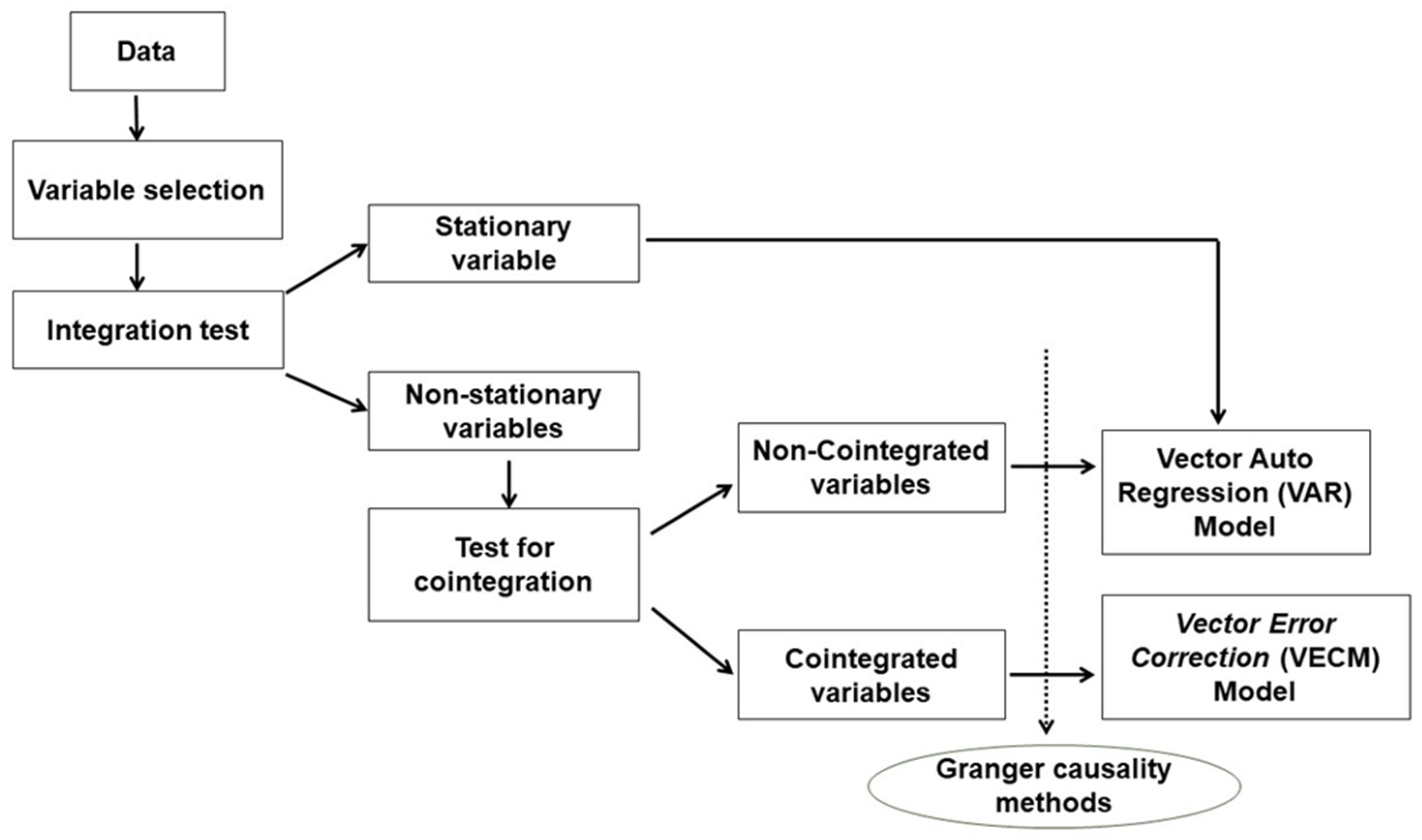
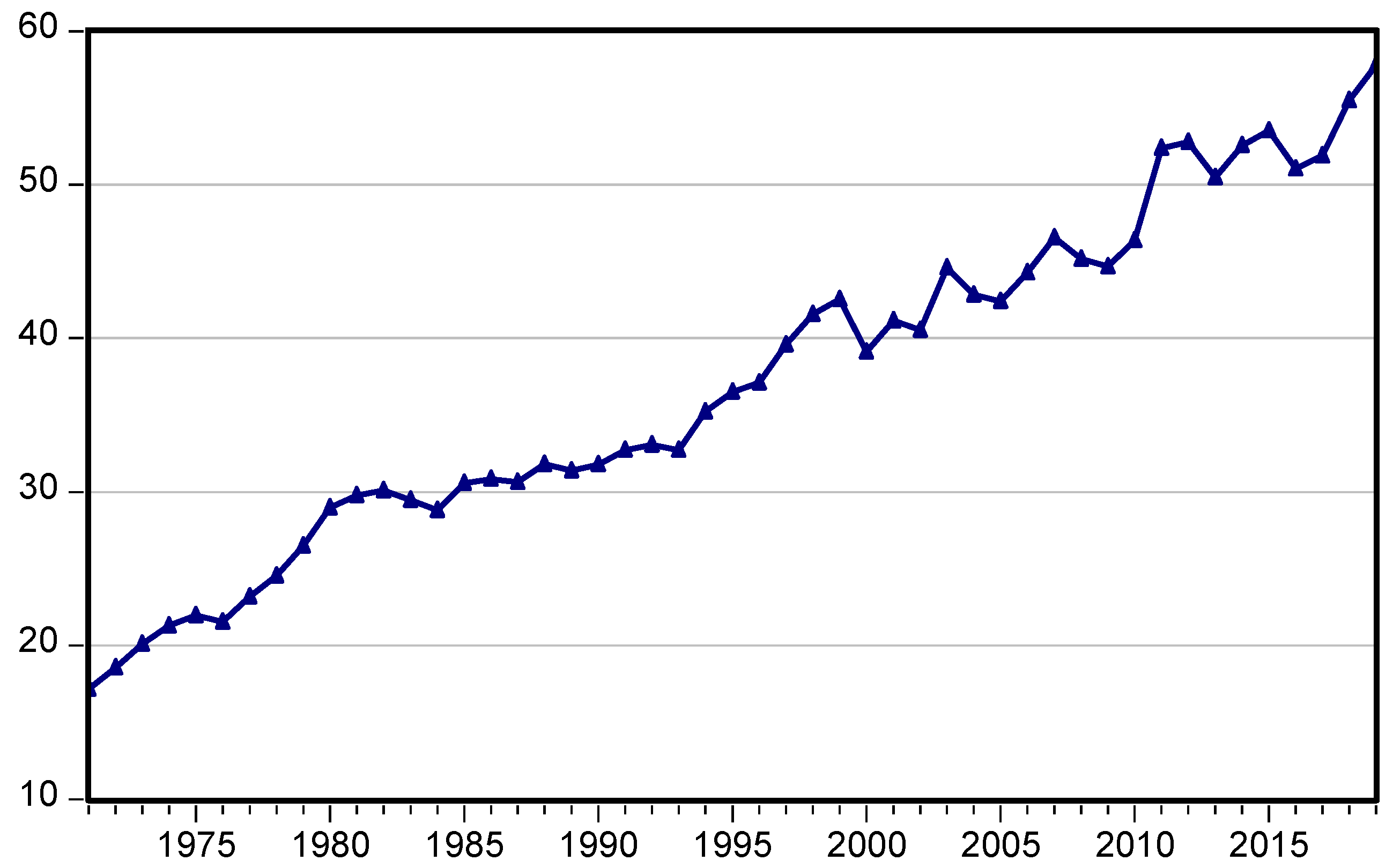
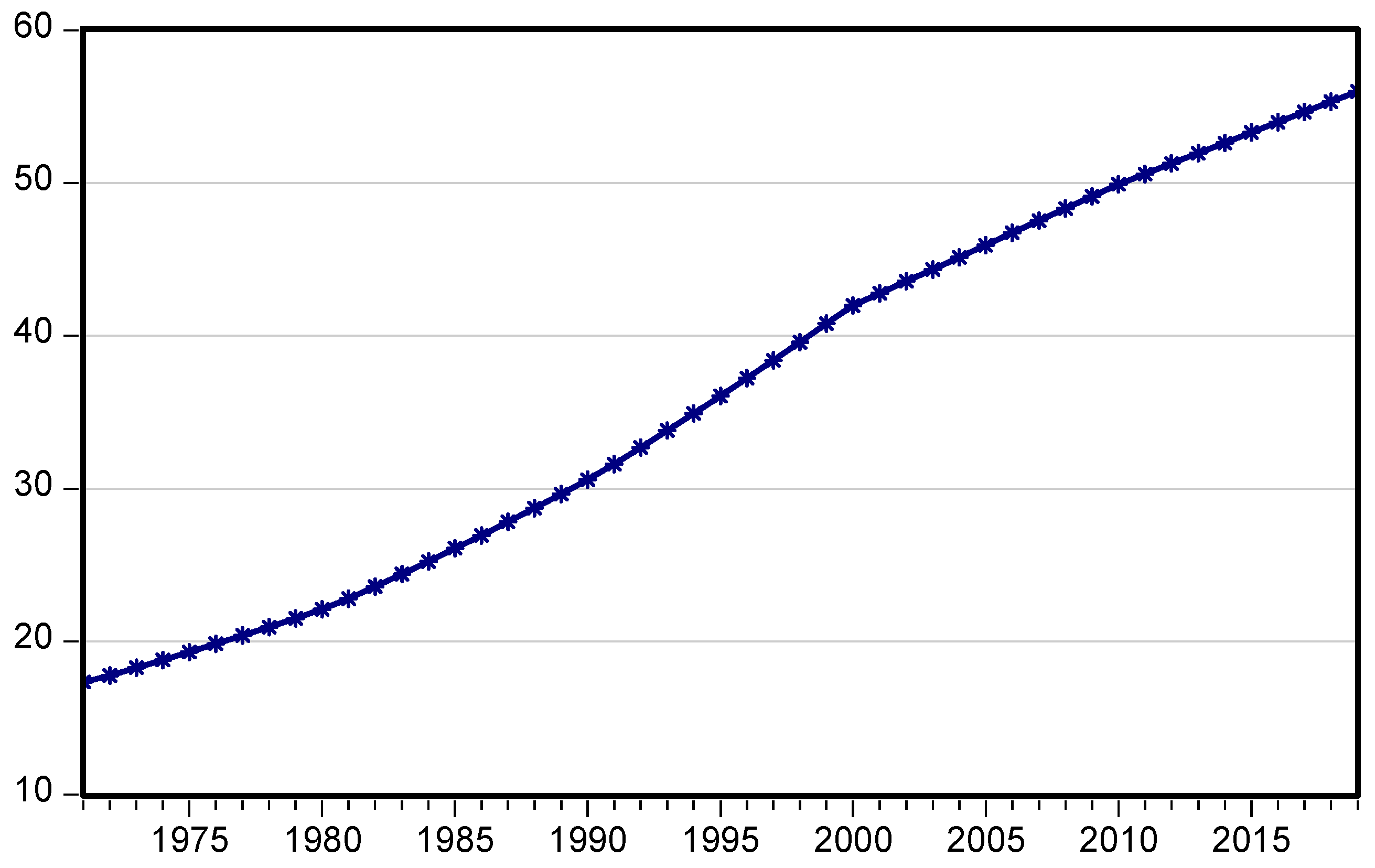
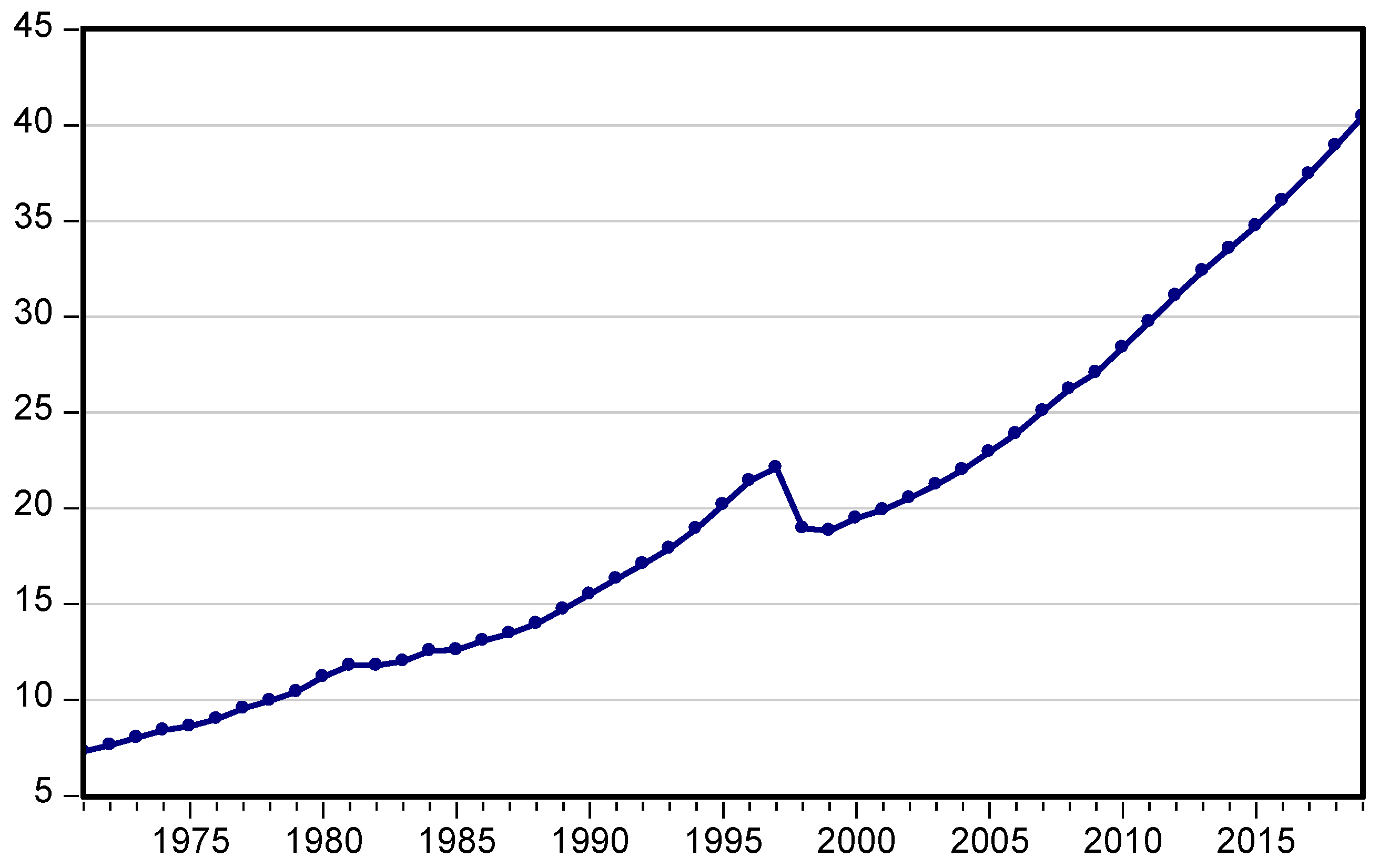
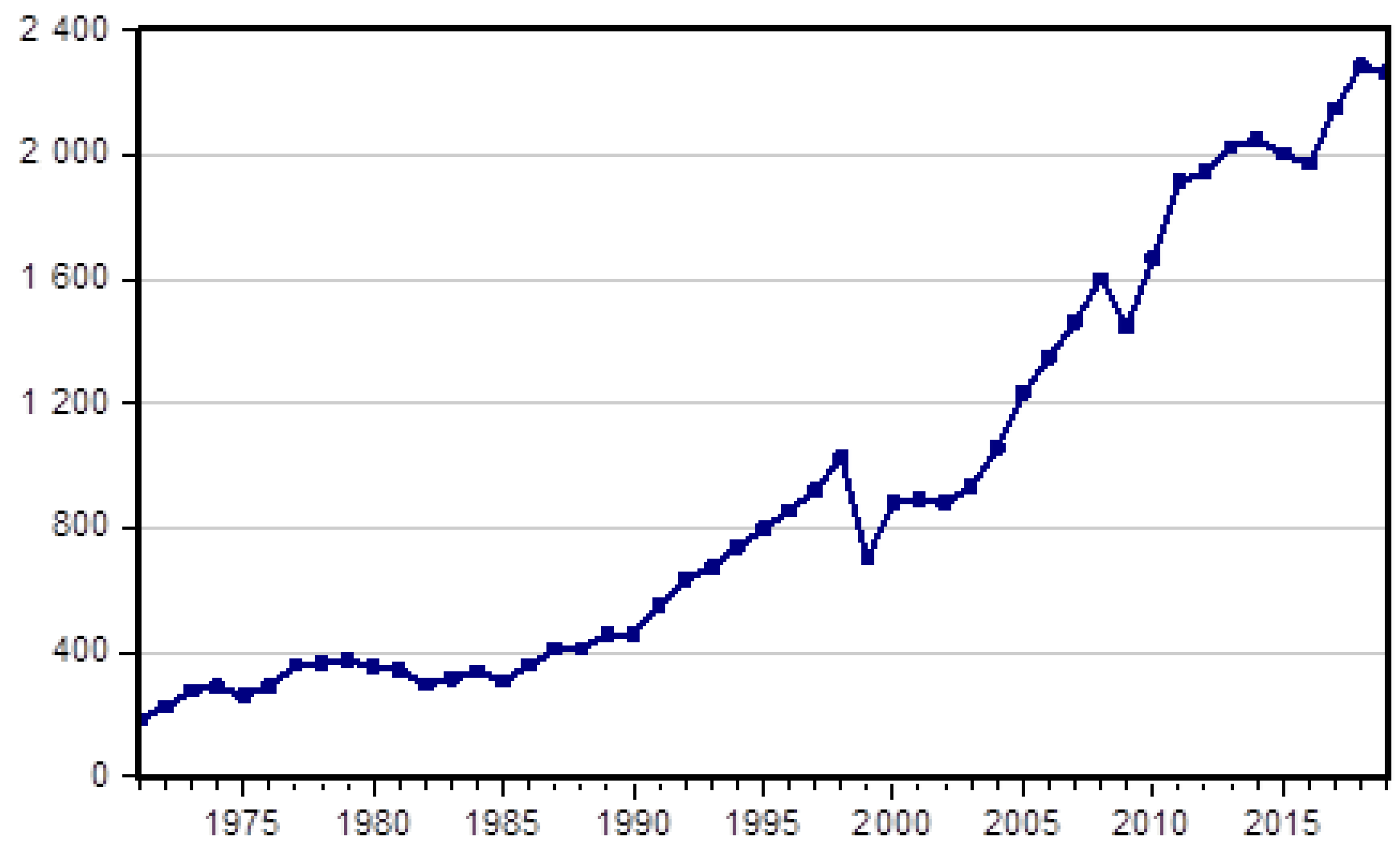
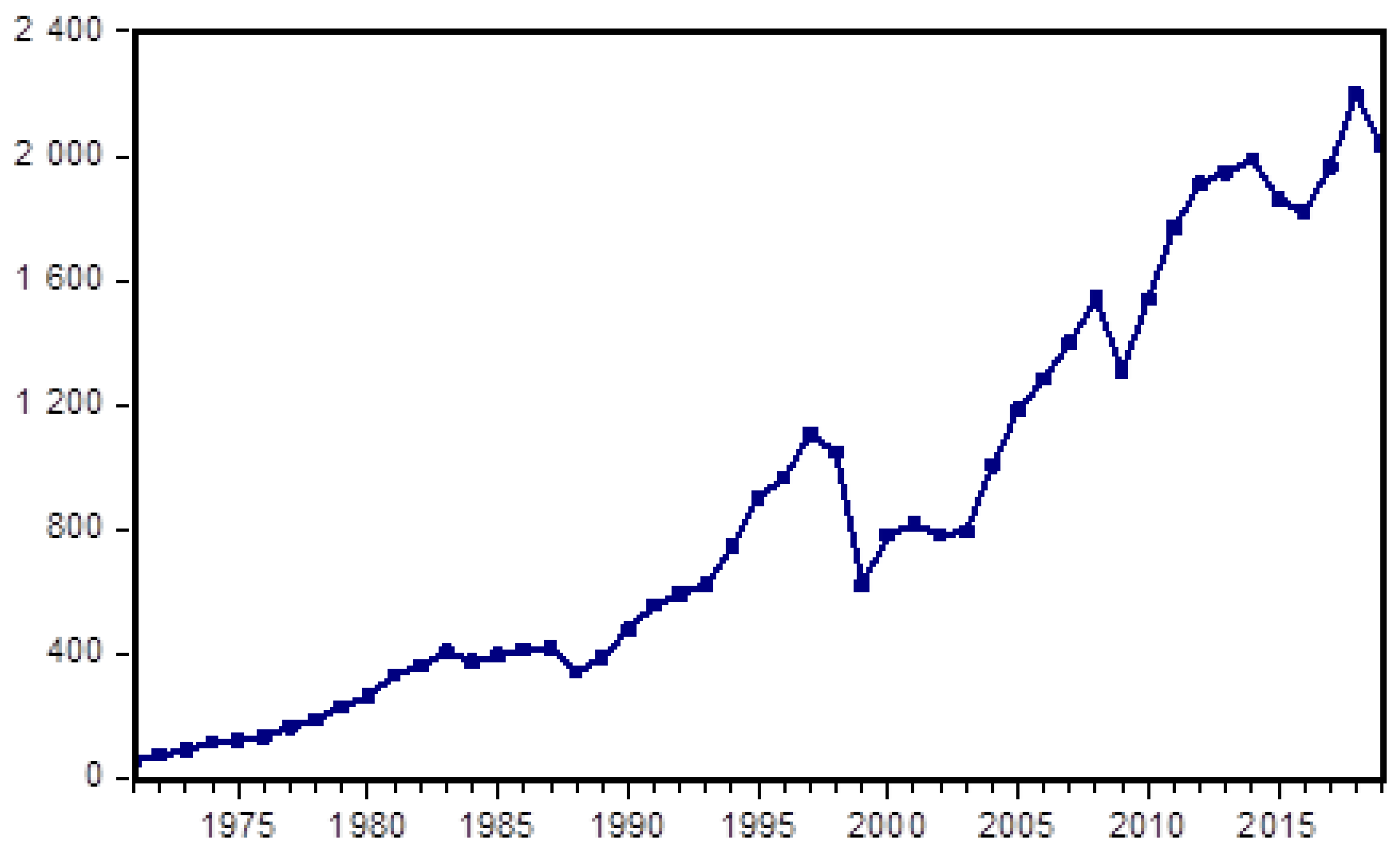
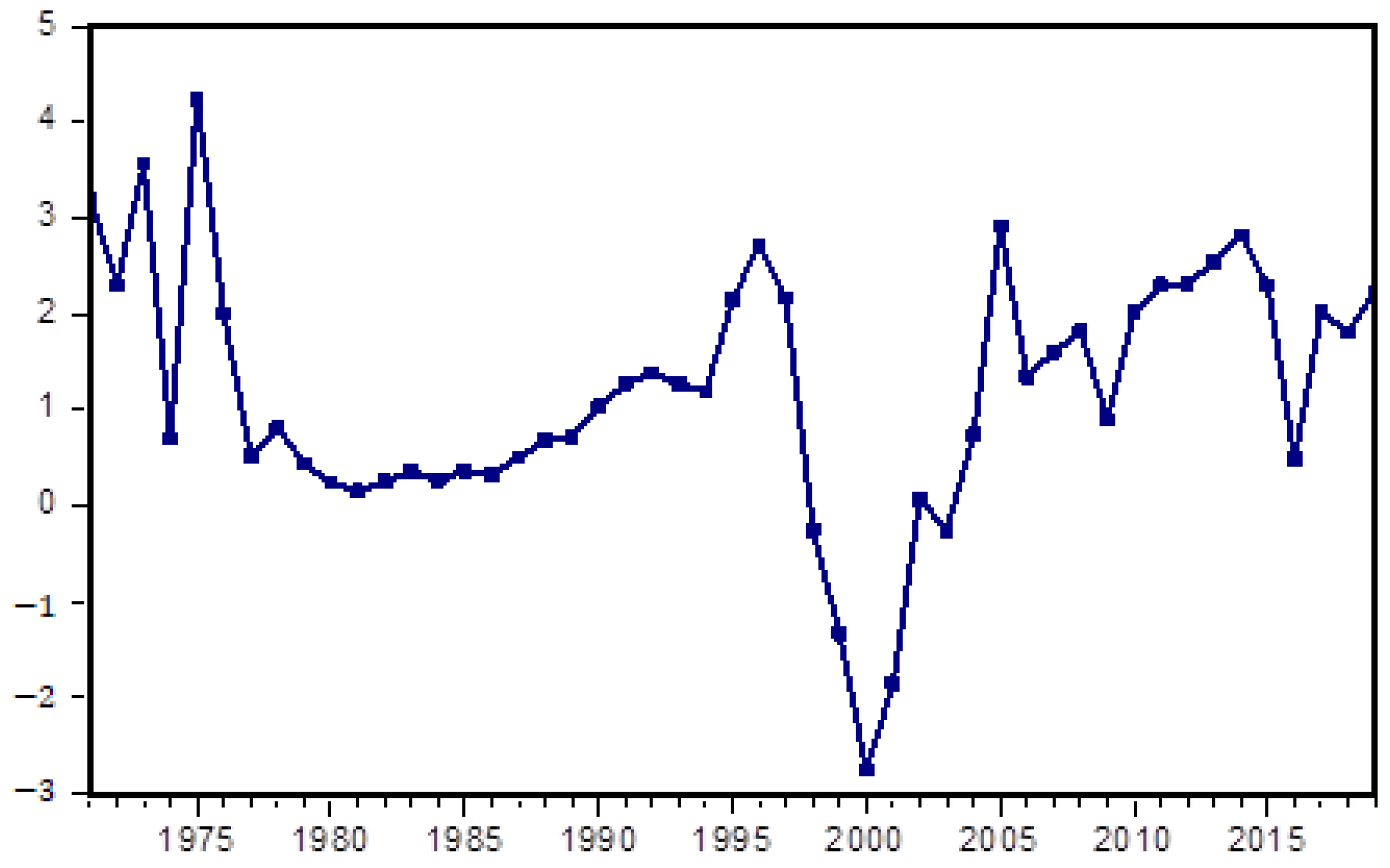
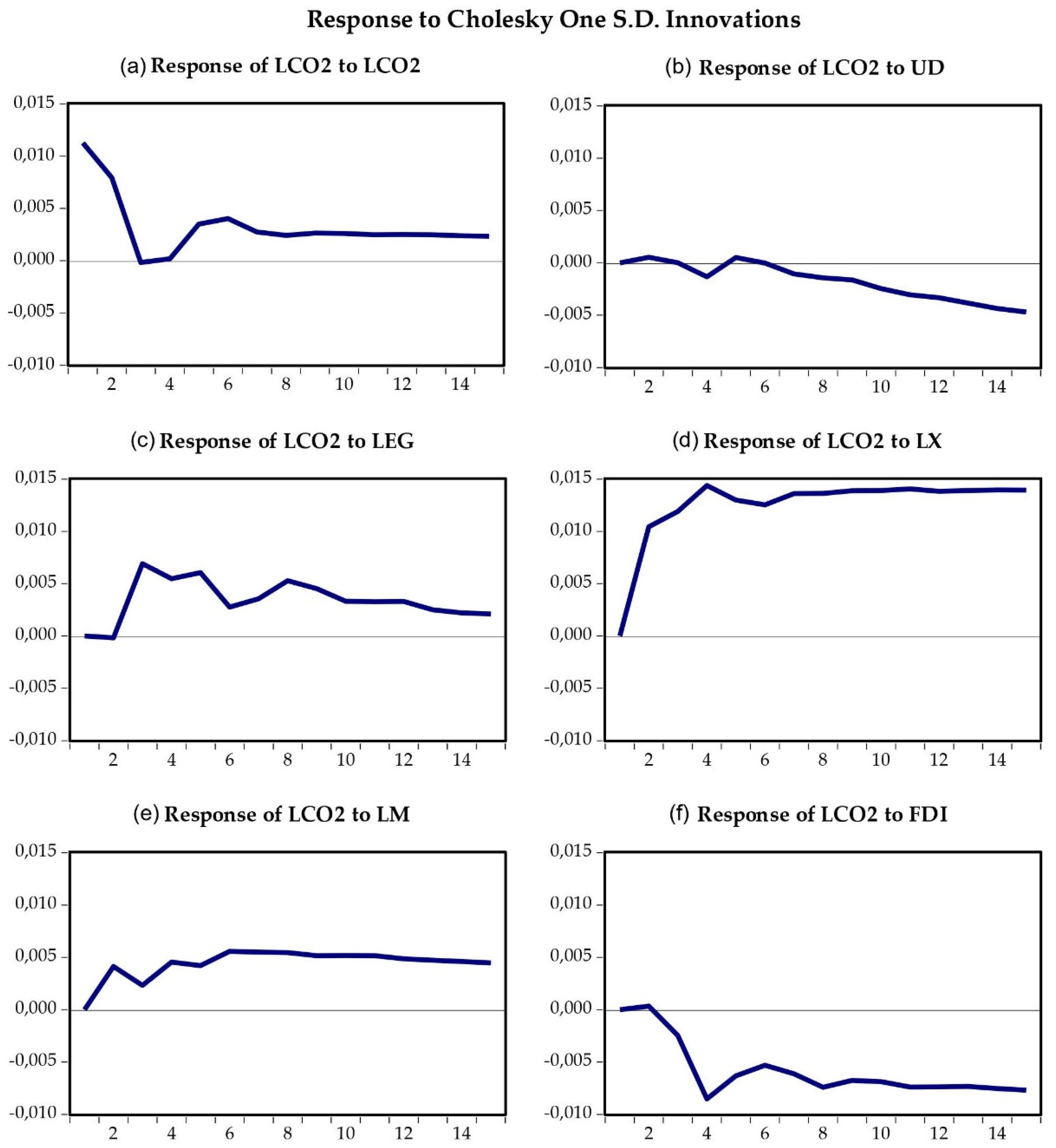
| Authors | Country/Region (Periods) | Technique Analysis | Findings |
|---|---|---|---|
| Economy Growth and CO2 emissions | |||
| Rahman et al. (2020) | 5 South Asian Countries (1990–2017) | Granger causality, VECM FMOLS, DOLS, generalized method of moments (GMM) | ECO2 + EG EG ↔ ECO2 |
| Wang et al. (2019) | 5 Countries: Germany, Italy, India, Taiwan and Japan (1950–2010) | Rolling regression | EG ∩ ECO2 |
| Vo et al. (2019) | ASEAN 5 (1971–2014) | Granger causality, FMOLS, DOLS | EG → ECO2 |
| Abbasi et al. (2020) | 8 Asia Countries (1982–2017) | Granger causality. | EG ≠ ECO2 |
| Chikaraishi et al. (2015) | 140 Countries (1980–2008) | Laten STIRPAT model | EG − ECO2 |
| Batool et al. (2021) | ASEAN 5 (1980–2018) | Granger causality, VECM | EG + ECO2 EG ≠ ECO2 (Ind, Mal) LR: EG ↔ ECO2 (Ind, Tha) SR: EG → ECO2 (Phi, Sgp) |
| Joshua et al. (2020) | South Africa | ARDL | EG + ECO2 EG → ECO2 |
| Phong et al. (2018) | Vietnam (1985–2015) | ARDL | EG + ECO2 |
| Bashir et al. (2019) | Indonesia (1985–2017) | VECM | EG ≠ ECO2 |
| Urbanization and CO2 emissions | |||
| Salahuddin et al. (2019) | South Africa (1980–2017) | Unit root tests (Zivot and Andrews single, dan Bai dan Perron), cointegration, ARDL | U ↔ ECO2 |
| Al-Mulali et al. (2013) | MENA Countries (1980–2009) | Pedroni’s cointegration, panel Granger causality | U ↔ ECO2 U + ECO2 |
| Hanif (2018) | 34 Countries in Africa (1995–2015) | System generalized method of moment (GMM) | U + ECO2 |
| Adedoyin and Bekun (2020) | 7 Countries (1995–2014) | Panel VAR approach, FMOLS, pooled mean group–ARDL | U ↔ ECO2 |
| Ali et al. (2017) | Singapore (1970–2015) | ARDL | U − ECO2 |
| Ali et al. (2019) | Pakistan (1972–2014) | ARDL, VECM | U + ECO2 U → ECO2 |
| Bekhet and Othman (2017) | Malaysia (1971–2015) | VECM, Granger causality | LR: U ↔ ECO2, Inv. Domestic ↔ E CO2 SR: U → E CO2 U → EG, Inv. Domestic → EG |
| Martínez-Zarzoso and Maruotti (2011) | Developing countries (1975–2003) | LSDVC, GMM methods | U ∩ ECO2 |
| Akorede and Afroz (2020) | Nigeria (1970–2017) | Causality tests, ARDL | U − ECO2 |
| Lin and Zhu (2018) | 282 Cities in China (2012) | Bayesian model average | U − ECO2 |
| Ergas et al. (2016) | USA (2002–2007) | A hybrid panel model | U − ECO2 |
| Borhan et al. (2012) | 8 East Asia | Simultaneous equation | ECO2-U |
| Dong et al. (2019) | 14 Countries maju | Two fixed-effect panel threshold models | SR: U ≠ ECO2 Middle Run : U − ECO2 |
| Economic Activities and CO2 emissions | |||
| Kizilkaya (2017) | Turkey (1970–2014) | ARDL | FDI ≠ ECO2 |
| Tang and Tan (2015) | Vietnam (1976–2009) | Cointegration, Granger causality | FDI ↔ ECO2 |
| Hasanov et al. (2018) | Azerbaijan, Bahrain, Kuwait, Oman, Qatar, Russia, Saudi Arabia, United Arab Emirates (UAE) and Venezuela (1995–2013) | PDOLS, PFMOLS, PMG methods, panel ECM | X − ECO2 M + ECO2 |
| Aljawareen and Saddam (2017) | 6 GCC Countries (1998–2008) | Panel data | FDI + ECO2 (Qatar) M − ECO2 (KSA) |
| Omri et al. (2014) | 54 Countries (1990–2011) | Dynamic simultaneous equation method, GMM Arellano and Bond. | FDI ↔ ECO2 |
| Amin et al. (2020) | 13 Asian (1985–2019) | Cointegration tests, FMOLS., Panel VECM | TO ↔ ECO2 U + ECO2 TO + ECO2 U ↔ ECO2 |
| Anwar et al. (2020) | East Asia (1980–2017) | Panel data | U + ECO2 TO + ECO2 |
| S. P. Nathaniel (2020) | Indonesia (1971–2014) | ARDL | U + ECO2 LR: TO + ECO2 SR: TO − ECO2 |
| Omri et al. (2015) | 12 MENA countries (1990–2011) | Generalized method of moments (GMM) | TO→ ECO2 |
| S. Nathaniel and Khan (2020) | ASEAN (1990–2016) | Unit root tests, ointegration. | EG → TO |
| Adams et al. (2020) | 19 Countries Sub-Saharan Africa (1980–2011) | Estimator IV-GMM | FDI- ECO2 |
| Aljawareen and Saddam (2017) | ASEAN 8 (1985–2015) | Panel unit root tests, Panel cointegration test, Forecast: Innovative Accounting Approach (IAA) | EG → TO |
| Chandran and Tang (2013) | ASEAN 5 (1971–2008) | Cointegration, Granger causality | FDI ≠ ECO2 FDI ↔ ECO2 (Tha, Mal) |
| Pié et al. (2018) | 30 Countries (1992–2012) | Bayesian framework | X − ECO2 M + ECO2 |
| Akalpler and Hove (2019) | India (1971–2014) | ARDL | ECO2 → X M → ECO2 M → EG (−) M → EG (+) |
| Salehnia et al. (2020) | 14 MENA Countries (2004–2016) | Panel quantile regression | FDI − ECO2 TO + ECO2 M + ECO2 X + ECO2 |
| Al-Mulali and Sheau-Ting (2014) | 189 Countries (1990–2011) | Panel fully modified OLS (FMOLS) | TO + ECO2 |
| Chen et al. (2021a) | 64 Countries (2001–2019) | Panel quantile regression | TO + ECO2 |
| Variable | Description | Unit | Source |
|---|---|---|---|
| CO2 emissions (CO2) | The residual CO2 that is discharged into the environment. | Tonnes CO2/Terajoule | International Energy Agency, 2021 |
| Economic growth (GDPC) | Gross Domestic Product per capita. | IDR in constant price | World Bank |
| Urbanization (UD) | The percentage of people living in urban areas. | % | World Bank |
| Export (X) | The value of exports made by a country. | IDR in constant price | World Bank |
| Import (M) | The value of imports of goods to a country. | IDR in constant price | World Bank |
| Foreign direct investment (FDI) | Net inflow as the proportion of total Gross Domestic Product. | % | World Bank |
| Variable | Maximum | Minimum | Mean | Std. Dev. | Observations |
|---|---|---|---|---|---|
| LCO2 | 1.762 | 1.235 | 1.549 | 0.136 | 49 |
| UD | 55.985 | 17.338 | 36.176 | 12.588 | 49 |
| LEG | 7.607 | 6.864 | 7.247 | 0.209 | 49 |
| LX | 15.359 | 14.258 | 14.852 | 0.328 | 49 |
| LM | 15.342 | 13.771 | 14.777 | 0.423 | 49 |
| FDI | 4.241 | −2.757 | 1.198 | 1.335 | 49 |
| Variable | ADF | PP | ||
|---|---|---|---|---|
| t-Statistic | Prob. | t-Statistic | Prob. | |
| Level | ||||
| LCO2 | −1.802599 | 0.3748 | −2.454673 | 0.1329 |
| UD | −1.697425 | 0.4258 | 0.198221 | 0.9697 |
| LEG | −0.618192 | 0.8566 | −0.606277 | 0.8593 |
| LX | −0.630870 | 0.8536 | −0.601572 | 0.8603 |
| LM | −2.536889 | 0.1135 | −2.592632 | 0.1016 |
| FDI | −3.296863 | 0.0206 | −3.348542 | 0.0181 |
| First difference | ||||
| LCO2 | −5.806780 | 0.0000 * | −7.190028 | 0.0000 * |
| UD | −1.579417 | 0.4848 | −1.648529 | 0.4502 |
| LEG | −5.103162 | 0.0001 * | −5.072025 | 0.0001 * |
| LX | −8.107578 | 0.0000 * | −8.160933 | 0.0000 * |
| LM | −6.087550 | 0.0000 * | −6.087550 | 0.0000 * |
| FDI | −9.123195 | 0.0000 * | −9.067042 | 0.0000 * |
| Second difference | ||||
| UD | −6.02711 | 0.0000 * | −5.980405 | 0.0000 * |
| Method | Level | First Different | ||
|---|---|---|---|---|
| Statistic | Prob. | Statistic | Prob. | |
| Levin, Lin & Chu t * | −0.23198 | 0.4083 | −7.51263 | 0.0000 * |
| Im, Pesaran and Shin W-stat | −0.50251 | 0.3077 | −12.0491 | 0.0000 * |
| ADF-Fisher Chi-square | 15.9249 | 0.1947 | 133.866 | 0.0000 * |
| PP-Fisher Chi-square | 15.4927 | 0.2156 | 135.685 | 0.0000 * |
| Hypothesis | Eigenvalue | Trace-Test | Max-Eigen Test | ||
|---|---|---|---|---|---|
| Statistic | Statistic | ||||
| None | 0.731063 | 136.8953 | 0.0000 * | 60.41077 | 0.0001 * |
| At most 1 | 0.504075 | 76.48456 | 0.0133 ** | 32.26119 | 0.0770 |
| At most 2 | 0.361128 | 44.22337 | 0.1054 | 20.61038 | 0.3004 |
| At most 3 | 0.242559 | 23.61299 | 0.2173 | 12.77925 | 0.4727 |
| At most 4 | 0.159968 | 10.83374 | 0.2219 | 8.018521 | 0.3768 |
| At most 5 | 0.059365 | 2.815217 | 0.0934 | 2.815217 | 0.0934 |
| Dependent Variable | Short Run | Long Run | ||||||
|---|---|---|---|---|---|---|---|---|
| ΔL(CO2) | ΔUD | ΔL(EG) | ΔL(X) | ΔL(M) | ΔFDI | Coefficient | t-Test | |
| ΔL(CO2) | - | 18.72401 (0.0001) * | 6.126103 (0.0467) ** | 1.802927 (0.406) | 10.50891 (0.0052) * | 31.76471 (0.000) * | −0.863939 | −7.31613 * |
| ΔUD | 0.885313 (0.6423) | - | 0.894056 (0.6395) | 1.505821 (0.471) | 9.9198 (0.007) * | 0.759596 (0.684) | 0.62141 | 1.15879 |
| ΔL(EG) | 0.020633 (0.9897) | 3.397833 (0.1829) | - | 0.255068 (0.8803) | 0.241267 (0.8864) | 1.068797 (0.586) | −0.126233 | −0.80081 |
| ΔL(X) | 2.835755 (0.2422) | 2.549941 (0.2794) | 16.40749 (0.0003) * | - | 0.363593 (0.8338) | 0.042006 (0.9792) | 0.518394 | 1.31906 |
| ΔL(M) | 2.0033835 (0.3673) | 1.69154 (0.4292) | 30.15772 (0.0000) * | 2.537506 (0.2812) | - | 0.027722 (0.9862) | −0.017462 | −0.03758 |
| ΔFDI | 2.94009 (0.2299) | 4.537871 (0.1034) | 2.024757 (0.3634) | 1.783195 (0.4100) | 3.849635 (0.1459) | - | 11.73753 | 1.06675 |
| Period | S.E. | Illustrated by Variable (%) | |||||
|---|---|---|---|---|---|---|---|
| LCO2 | UD | LEG | LX | LM | FDI | ||
| 1 | 0.01126 | 100 | 0 | 0 | 0 | 0 | 0 |
| 2 | 0.01778 | 60.0086 | 0.08991 | 0.00916 | 34.4567 | 5.39887 | 0.03685 |
| 3 | 0.02273 | 36.7204 | 0.05502 | 9.20014 | 48.4918 | 4.34863 | 1.18405 |
| 4 | 0.02912 | 22.3715 | 0.24277 | 9.14684 | 53.8769 | 5.08307 | 9.27894 |
| 5 | 0.03352 | 17.9672 | 0.20705 | 10.1653 | 55.6899 | 5.41679 | 10.5537 |
| 6 | 0.03693 | 15.9996 | 0.17066 | 8.9383 | 57.3913 | 6.7383 | 10.7619 |
| 7 | 0.04047 | 13.7793 | 0.21075 | 8.2149 | 59.0947 | 7.45419 | 11.2462 |
| 8 | 0.04409 | 11.9095 | 0.28457 | 8.34995 | 59.3394 | 7.81342 | 12.3031 |
| 9 | 0.04731 | 10.6518 | 0.36451 | 8.16321 | 60.1271 | 7.9719 | 12.7215 |
| 10 | 0.05029 | 9.69206 | 0.56157 | 7.65746 | 60.8523 | 8.11226 | 13.1244 |
| 11 | 0.05324 | 8.86569 | 0.83062 | 7.21289 | 61.2709 | 8.17552 | 13.6444 |
| 12 | 0.05596 | 8.22208 | 1.10796 | 6.87468 | 61.5566 | 8.15348 | 14.0852 |
| 13 | 0.05855 | 7.68971 | 1.4459 | 6.46236 | 61.8715 | 8.09846 | 14.4321 |
| 14 | 0.06108 | 7.21843 | 1.83961 | 6.06841 | 62.0817 | 8.00712 | 14.7847 |
| 15 | 0.06353 | 6.80859 | 2.24968 | 5.71815 | 62.1948 | 7.8946 | 15.1342 |
Publisher’s Note: MDPI stays neutral with regard to jurisdictional claims in published maps and institutional affiliations. |
© 2022 by the authors. Licensee MDPI, Basel, Switzerland. This article is an open access article distributed under the terms and conditions of the Creative Commons Attribution (CC BY) license (https://creativecommons.org/licenses/by/4.0/).
Share and Cite
Nihayah, D.M.; Mafruhah, I.; Hakim, L.; Suryanto, S. CO2 Emissions in Indonesia: The Role of Urbanization and Economic Activities towards Net Zero Carbon. Economies 2022, 10, 72. https://doi.org/10.3390/economies10040072
Nihayah DM, Mafruhah I, Hakim L, Suryanto S. CO2 Emissions in Indonesia: The Role of Urbanization and Economic Activities towards Net Zero Carbon. Economies. 2022; 10(4):72. https://doi.org/10.3390/economies10040072
Chicago/Turabian StyleNihayah, Dyah Maya, Izza Mafruhah, Lukman Hakim, and Suryanto Suryanto. 2022. "CO2 Emissions in Indonesia: The Role of Urbanization and Economic Activities towards Net Zero Carbon" Economies 10, no. 4: 72. https://doi.org/10.3390/economies10040072
APA StyleNihayah, D. M., Mafruhah, I., Hakim, L., & Suryanto, S. (2022). CO2 Emissions in Indonesia: The Role of Urbanization and Economic Activities towards Net Zero Carbon. Economies, 10(4), 72. https://doi.org/10.3390/economies10040072






